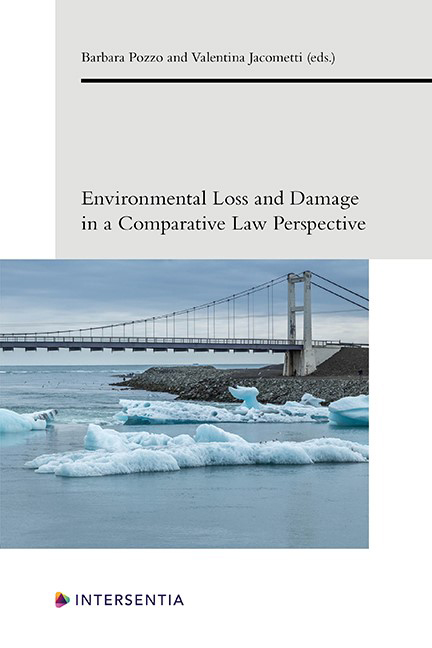Book contents
- Frontmatter
- Preface
- Contents
- List of Authors
- PART I LIABILITY FOR ENVIRONMENTAL HARM IN THE EU
- PART II PRIVATE AND CORPORATE ENVIRONMENTAL LIABILITY
- PART III THE ROLE OF CRIMINAL LIABILITY
- PART IV LEGAL TRANSPLANTS IN THE ENVIRONMENTAL FIELD: THE CASE OF ENVIRONMENTAL LIABILITY
- PART V STATE AND INTERNATIONAL ENVIRONMENTAL LIABILITY
- PART VI CLIMATE CHANGE LIABILITY
- PART VII LIABILITY, CLIMATE CHANGE AND NATURAL HAZARDS: THE ROLE OF INSURANCE
- PART VIII REAL COMPENSATION AND OFFSET REGIMES: THE STRATEGY OF “NO NET LOSS”
- About the Editors
The Permit Defence Between the EU Environmental Liability Directive and National Private Law: Some Comparative Law Remarks
Published online by Cambridge University Press: 26 May 2021
- Frontmatter
- Preface
- Contents
- List of Authors
- PART I LIABILITY FOR ENVIRONMENTAL HARM IN THE EU
- PART II PRIVATE AND CORPORATE ENVIRONMENTAL LIABILITY
- PART III THE ROLE OF CRIMINAL LIABILITY
- PART IV LEGAL TRANSPLANTS IN THE ENVIRONMENTAL FIELD: THE CASE OF ENVIRONMENTAL LIABILITY
- PART V STATE AND INTERNATIONAL ENVIRONMENTAL LIABILITY
- PART VI CLIMATE CHANGE LIABILITY
- PART VII LIABILITY, CLIMATE CHANGE AND NATURAL HAZARDS: THE ROLE OF INSURANCE
- PART VIII REAL COMPENSATION AND OFFSET REGIMES: THE STRATEGY OF “NO NET LOSS”
- About the Editors
Summary
INTRODUCTION: AIM AND SOME VOCABULARY
“Permit defence” is a common way of addressing Article 8(4)(a) Directive 2004/35/CE, according to which:
The Member States may allow the operator not to bear the cost of remedial actions taken pursuant to this Directive where he demonstrates that he was not at fault or negligent and that the environmental damage was caused by: (a) an emission or event expressly authorised by, and fully in accordance with the conditions of, an authorisation conferred by or given under applicable national laws and regulations which implement those legislative measures adopted by the Community specified in Annex III, as applied at the date of the emission or event.
The expression “permit defence” is clearly inspired by private law language. In particular, defences in civil trials are submissions made by the defendant, according to which “for some particular reason, plaintiff's claim did not arise, has in the interim been lost, or is barred” or through which “defendant raises an individual right which he enjoys against plaintiff”. In legal English, especially American legal English, there is also a “partial defence”, which goes “either to part of the action or toward mitigation of damages”.
This chapter analyses Article 8(4) Directive 2004/35/CE in order to ascertain the relationship between EU law and private law.
After a short drafting history, the effects of the EU permit defence will be examined, highlighting the problem of distinguishing between legal and illegal activities. The chapter will then explore how private law liability systems of Member States deal with the same problem, paying particular attention to select rules of tort law and nuisance in Germany, France and Italy. Finally, national transposition and implementation measures of the EU Directive will be studied and compared with national private law rules, with the intention of measuring their coherence with the legal traditions of the respective Member States.
SOME DRAFTING HISTORY
The original Proposal of this Directive drafted by the European Commission (COM/2002/0017 final – COD 2002/0021) would have allowed a very broad “permit defence”, as its Article 9(1)(c) merely stated that “this Directive shall not cover environmental damage or an imminent threat of such damage caused by an emission or event allowed in applicable laws and regulations, or in the permit or authorisation issued to the operator”. This was partially due to lobbying efforts of industry and professional associations.
- Type
- Chapter
- Information
- Publisher: IntersentiaPrint publication year: 2021



